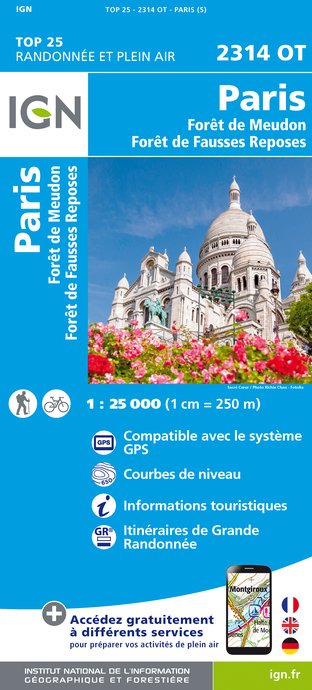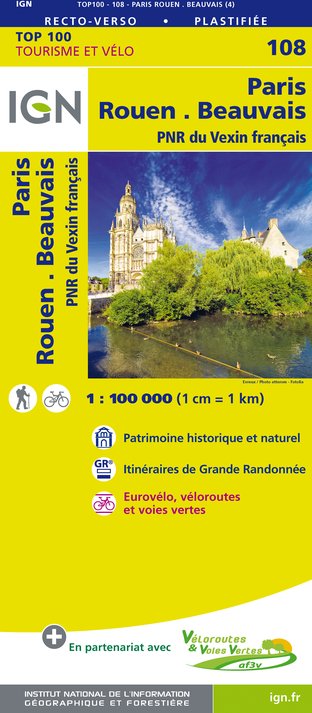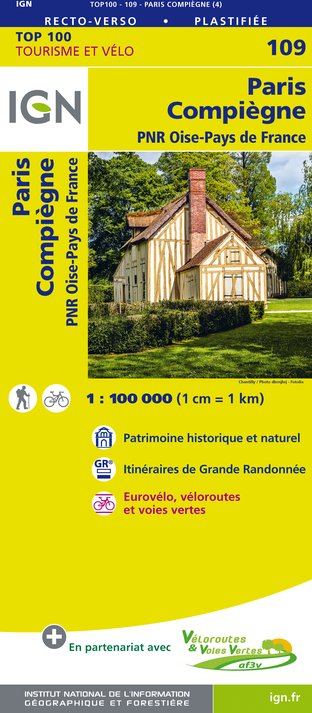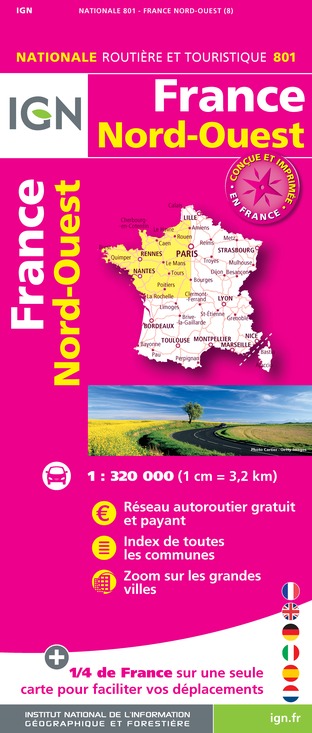Allarme
Allarmi
Tipo di pratica
In barca
A piedi
In bicicletta
Presentazione
Mappa
Punti di interesse
Sintesi di Cirkwi
Valutazioni e recensioni
Vedi nei dintorni
Parigi in Batobus



Credito : Batobus
Il breve di Cirkwi
Esplora Parigi in barca: scopri l'itinerario del Batobus
Curato da Balades Fluviales Fabienne Lemoine Fondateur, il tour del Batobus offre un'esperienza parigina unica mentre scivoli lungo la Senna. Abbandona l'ordinaria frenesia delle visite urbane per un viaggio sereno che collega luoghi iconici con la comodità del trasporto fluviale. Questo viaggio attraversa i cuori di Parigi, dalla maestosa Torre Eiffel al faro culturale di Trocadéro. È un invito ad osservare le meraviglie architettoniche di Parigi e il ritmo del fiume - una narrazione creata per coloro che desiderano svelare l'essenza della città nella tranquillità.
Insight tecnici sull'itinerario
Un circuito completo copre oltre 9,8 chilometri, con lievi fluttuazioni altimetriche che vanno da 27 a 30 metri. Il viaggio incontra un minimo cambiamento di altitudine positivo e negativo, precisamente 11 metri, rendendolo notevolmente pianeggiante. Questi dati evidenziano un percorso accessibile e rilassante ideale per visitatori di tutte le età, promettendo una facile esplorazione delle pittoresche rive della Senna e delle gemme architettoniche di Parigi senza sforzo fisico.
Consigli stagionali per il viaggio in Batobus
Indipendentemente dalla stagione, l'esperienza del Batobus è incantevole. Tuttavia, la primavera e l'autunno offrono un clima mite, migliorando le passeggiate tranquille sul molo. Per i viaggiatori estivi, la protezione solare e l'idratazione sono fondamentali, poiché il fascino del fiume è più luminoso sotto il sole. I viaggiatori invernali dovrebbero vestirsi caldamente, assicurandosi che il freddo non distolga dalla bellezza delle serate illuminate di Parigi. Per quanto riguarda la sicurezza, rimanete sempre consapevoli del vostro ambiente e seguite le istruzioni dell'equipaggio, specialmente durante l'imbarco o lo sbarco.
Parigi, cuore della cultura e della storia francese
Parigi non è solo la capitale della Francia; è un intreccio storico che ha influenzato la cultura mondiale, l'arte e la politica per secoli. Situata nella regione dell'Île-de-France, le sue sponde sulla Senna hanno assistito a momenti cruciali, dalla Rivoluzione francese alle rivoluzionarie Esposizioni Universali. Questa città, che incarna libertà, creatività e resilienza, è magnificamente mostrata mentre ci si muove lungo la sua arteria vitale, la Senna, osservando monumenti che raccontano storie di trionfo, tragedia e trasformazione.
Capire il clima di Parigi per i viaggiatori
Parigi gode di un clima temperato, caratterizzato da inverni miti e estati piacevolmente calde. La città registra precipitazioni uniformemente durante tutto l'anno, con occasionali nevicate in inverno. Il periodo migliore per godersi un tour in Batobus, considerando il clima, sarebbe la fine della primavera fino all'inizio dell'autunno (da maggio a settembre), quando il tempo è più favorevole per le visite turistiche e per godere del ponte aperto, con poche interruzioni di pioggia e una gamma confortevole di temperature che facilitano l'esplorazione prolungata delle rive del fiume e dei luoghi di interesse adiacenti.
Curato da Balades Fluviales Fabienne Lemoine Fondateur, il tour del Batobus offre un'esperienza parigina unica mentre scivoli lungo la Senna. Abbandona l'ordinaria frenesia delle visite urbane per un viaggio sereno che collega luoghi iconici con la comodità del trasporto fluviale. Questo viaggio attraversa i cuori di Parigi, dalla maestosa Torre Eiffel al faro culturale di Trocadéro. È un invito ad osservare le meraviglie architettoniche di Parigi e il ritmo del fiume - una narrazione creata per coloro che desiderano svelare l'essenza della città nella tranquillità.
Insight tecnici sull'itinerario
Un circuito completo copre oltre 9,8 chilometri, con lievi fluttuazioni altimetriche che vanno da 27 a 30 metri. Il viaggio incontra un minimo cambiamento di altitudine positivo e negativo, precisamente 11 metri, rendendolo notevolmente pianeggiante. Questi dati evidenziano un percorso accessibile e rilassante ideale per visitatori di tutte le età, promettendo una facile esplorazione delle pittoresche rive della Senna e delle gemme architettoniche di Parigi senza sforzo fisico.
Consigli stagionali per il viaggio in Batobus
Indipendentemente dalla stagione, l'esperienza del Batobus è incantevole. Tuttavia, la primavera e l'autunno offrono un clima mite, migliorando le passeggiate tranquille sul molo. Per i viaggiatori estivi, la protezione solare e l'idratazione sono fondamentali, poiché il fascino del fiume è più luminoso sotto il sole. I viaggiatori invernali dovrebbero vestirsi caldamente, assicurandosi che il freddo non distolga dalla bellezza delle serate illuminate di Parigi. Per quanto riguarda la sicurezza, rimanete sempre consapevoli del vostro ambiente e seguite le istruzioni dell'equipaggio, specialmente durante l'imbarco o lo sbarco.
Parigi, cuore della cultura e della storia francese
Parigi non è solo la capitale della Francia; è un intreccio storico che ha influenzato la cultura mondiale, l'arte e la politica per secoli. Situata nella regione dell'Île-de-France, le sue sponde sulla Senna hanno assistito a momenti cruciali, dalla Rivoluzione francese alle rivoluzionarie Esposizioni Universali. Questa città, che incarna libertà, creatività e resilienza, è magnificamente mostrata mentre ci si muove lungo la sua arteria vitale, la Senna, osservando monumenti che raccontano storie di trionfo, tragedia e trasformazione.
Capire il clima di Parigi per i viaggiatori
Parigi gode di un clima temperato, caratterizzato da inverni miti e estati piacevolmente calde. La città registra precipitazioni uniformemente durante tutto l'anno, con occasionali nevicate in inverno. Il periodo migliore per godersi un tour in Batobus, considerando il clima, sarebbe la fine della primavera fino all'inizio dell'autunno (da maggio a settembre), quando il tempo è più favorevole per le visite turistiche e per godere del ponte aperto, con poche interruzioni di pioggia e una gamma confortevole di temperature che facilitano l'esplorazione prolungata delle rive del fiume e dei luoghi di interesse adiacenti.
Generato automaticamente.
IGN Carte

2314OT - PARIS FORÊT DE MEUDON FORÊT DE FAUSSES REPOSES
Editore : IGN
Collezione : TOP 25 ET SÉRIE BLEUE
Scala : 1:25 000
13.90€

190 PARIS CHANTILLY FONTAINEBLEAU
Editore : IGN
Collezione : TOP 100
Scala : 1:100 000
8.40€

118 PARIS CHARTRES PNR DE LA HAUTE VALLÉE DE CHEVREUSE
Editore : IGN
Collezione : TOP 100
Scala : 1:100 000
8.40€

108 PARIS ROUEN BEAUVAIS PNR DU VEXIN FRANÇAIS
Editore : IGN
Collezione : TOP 100
Scala : 1:100 000
8.40€

109 PARIS COMPIÈGNE PNR OISE-PAYS DE FRANCE
Editore : IGN
Collezione : TOP 100
Scala : 1:100 000
8.40€

D75-95 ÎLE-DE-FRANCE OUEST
Editore : IGN
Collezione : CARTES DÉPARTEMENTALES IGN
Scala : 1:150 000
5.90€

D77 SEINE-ET-MARNE
Editore : IGN
Collezione : CARTES DÉPARTEMENTALES IGN
Scala : 1:150 000
5.90€

D28 EURE-ET-LOIR
Editore : IGN
Collezione : CARTES DÉPARTEMENTALES IGN
Scala : 1:150 000
5.90€

NR01 HAUTS-DE-FRANCE
Editore : IGN
Collezione : CARTES RÉGIONALES IGN
Scala : 1:250 000
6.80€

NR08 CENTRE-VAL DE LOIRE
Editore : IGN
Collezione : CARTES RÉGIONALES IGN
Scala : 1:250 000
6.80€

NR03 ÍLE DE FRANCE
Editore : IGN
Collezione : CARTES RÉGIONALES IGN
Scala : 1:250 000
6.80€

801 FRANCE NORD OUEST
Editore : IGN
Collezione : CARTES NATIONALES IGN
Scala : 1:320 000
6.10€

EUROPE
Editore : IGN
Collezione : DÉCOUVERTE DES PAYS DU MONDE IGN
Scala : 1:2 500 000
7.00€
Informazioni tecniche
In barca
Difficoltà
Non specificata
Dist.
9.9 km
Tipo di pratica
In barca
A piedi
In bicicletta
Mostra di più
Profilo altimetrico
Punto di partenza
75007
Paris
Lat : 48.861687Lng : 2.295842
Punti di interesse
Autore dei dati
Valutazioni e recensioni
Da vedere nei dintorni








